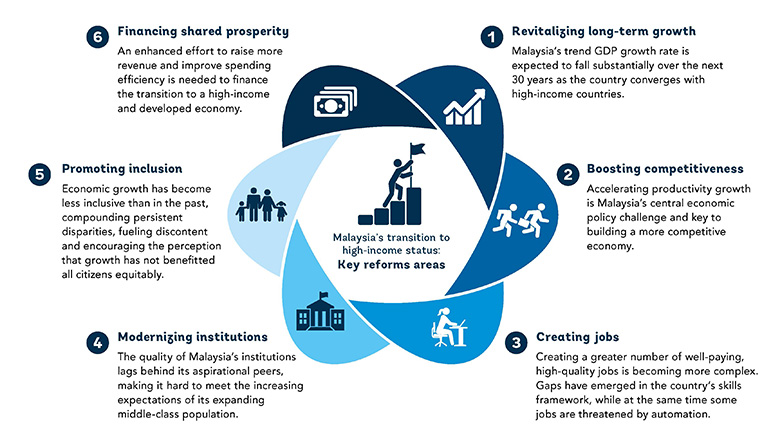The Malaysian economy is approaching a significant juncture as it nears its transition into a high-income and developed economy.
Despite the triple shock of the COVID-19 pandemic, World Bank’s projections see the country’s likely transition from its current upper-middle-income economy to a high-income economy between 2024 and 2028.
This transition is not an easy one. In the past 30 years, only 33 countries have transitioned to high-income status.
Malaysia has seen great success in growing from a low- to upper-middle-income economy in just one generation.
- Gross National Income (GNI) per capita grew, on average, 6.9% per year between 1960 and 2017
- Less than 1% of the population lives below the international extreme poverty line of US$1.90 and only 2.7% live below the average poverty line among its upper-middle-income peers at US$5.50
- The country trades with nearly 90% of countries in the world, considerably higher than that of its transitional, regional, aspirational peer groups.
- Life expectancy at birth has steadily increased, from 59 years in the 1960s to 75 years in 2019.
These successes can largely be attributed to development policies consisting of the following pillars:
- Outward-oriented, labor-intensive growth
- Investments in basic human capital to raise labor productivity
- Credible economic governance to maintain macroeconomic stability
However, what worked in the past will not work in the future. Gearing up for a high-income transition will require different solutions to thrive.
Malaysia’s economy today is significantly different from its transitional and aspirational peers.
- Growth is slower, inequality is higher and high-skilled jobs make up a lower share of employment compared to other countries that have achieved high-income status in recent decades.
- Labor compensation, tax collection, spending on social protection, environmental management and control of corruption all lag behind high-income OECD countries.
Domestically, there is a growing sense that the aspirations of the country’s middle class are not being met – that the economy isn’t producing enough well-paying jobs and that the proceeds of growth have not been equitably shared.
To compete with other high-income countries, factor accumulation is no longer sufficient to maintain growth. Instead, broader economic development, focusing on the quality, rather than quantity, of economic growth is needed.

Achieving high-income status is almost a certainty for Malaysia, but navigating this next stage of development will require tough reforms in 6 key areas:
- Revitalizing long-term growth
- Greater investments in human capital
- Increasing female labor force participation
- Improving total factor productivity by boosting innovation, infrastructure, skills and institutional quality
- Boosting competitiveness
- Reforming key service sectors to promote competitive markets and improve competitiveness in manufacturing
- Increasing the effectiveness of competition policy and balancing competitive neutrality between the public and private operators
- Modernizing the investment ecosystem
- Aligning incentives to promote researcher-industry collaboration
- Creating jobs
- Improving basic education outcomes
- Upskilling and reskilling the workforce through more market-responsive academic and TVET education streams
- Improving immigration and emigration policies
- Modernizing institutions
- Strengthening competition within the state-business nexus and GLC ecosystem
- Strengthening parliamentary oversight by institutionalizing Parliamentary Select Committees, reintroducing the Parliament Services Act and increasing the use of Private Member’s Bills
- Enhancing the capacity of the public service to improve performance, and increase resistance to corruption and political interference
- Promoting inclusion
- Creating high-skilled, high-paying jobs as a facilitator to inclusive development
- Update benchmarks for monetary and non-monetary deprivation, which ensures higher practical standards of well-being
- Deepening the social safety net, by addressing deprivation and exclusion issues at the individual and household levels
- Financing shared prosperity
- Making the personal income tax framework more progressive and ensuring more equitable redistribution of income.
- Developing new sources of revenue at the state and local level
- Improving spending efficiency through consolidation and targeting of flagship programs.
